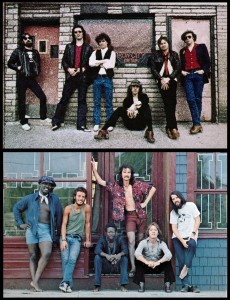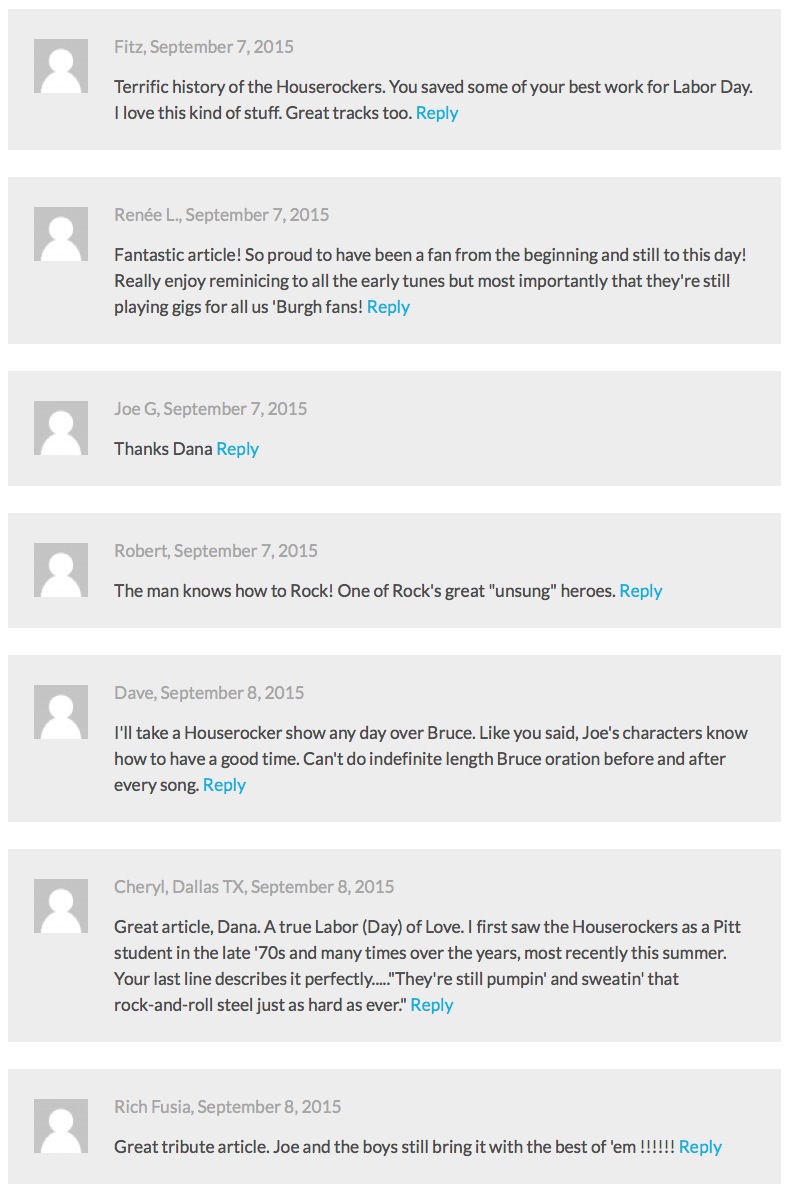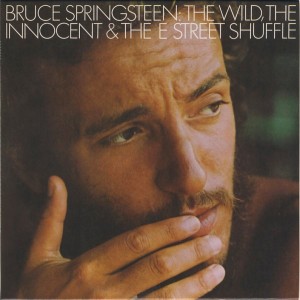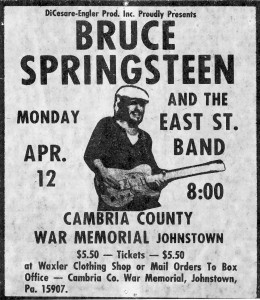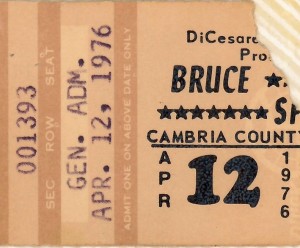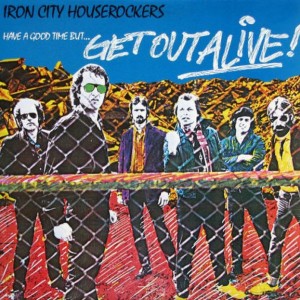 The band’s early lineup included founder, guitarist and vocalist Joe Grushecky, bass player Art Nardini, drummer Ned Rankin, guitarist Eddie Britt, keyboardist Gil Snyder, guitarist Gary Scalese, and harmonica player Marc Reisman. These guys knew a thing or two about the blue collar life. Grushecky’s dad was a coal miner and auto body worker, Nardini’s father was a mechanic, and Snyder’s pop worked construction. By the late 1970s they had developed a loyal following in the clubs and shot-and-a-beer joints of Pittsburgh, blasting out sounds that sprang from the musical well of the E Street Band, the Asbury Jukes, and the J. Geils Band.
The band’s early lineup included founder, guitarist and vocalist Joe Grushecky, bass player Art Nardini, drummer Ned Rankin, guitarist Eddie Britt, keyboardist Gil Snyder, guitarist Gary Scalese, and harmonica player Marc Reisman. These guys knew a thing or two about the blue collar life. Grushecky’s dad was a coal miner and auto body worker, Nardini’s father was a mechanic, and Snyder’s pop worked construction. By the late 1970s they had developed a loyal following in the clubs and shot-and-a-beer joints of Pittsburgh, blasting out sounds that sprang from the musical well of the E Street Band, the Asbury Jukes, and the J. Geils Band.
They released three excellent albums of original material between 1979 and 1981: “Love’s So Tough,” “Have a Good Time But Get Out Alive,” and “Blood on the Bricks.” The man known as the dean of American rock critics, Greil Marcus, called The Houserockers “the best rock band in the country” in a 1980 Village Voice article. David Fricke of Rolling Stone said that “Joe Grushecky’s lyrical muscle knocked the romantic stuffing out of pop’s generally sentimental portrait of working-class life.”
By the time I discovered The Houserockers’ working class repertoire in 1979, I had already been indoctrinated into Bruce Springsteen’s world of summer-in-the city street life and blue collar blues. It was a world populated on one hemisphere by dreamers and lovable ne’er-do-wells who scuffled on street corners and chased girls underneath the boardwalk, and on the other by disillusioned people with few choices, toiling away in factories and mills and bursting at the seams to break free of society’s chains.
But while the music and lyrics of The Houserockers’ songs were linked thematically to Bruce’s, they had a powerful and distinct sound and persona all their own. One major difference was the inclusion of harmonica on all their numbers. It gave the songs a gritty factory-whistle sound that perfectly fit the subject matter. Another difference was the overall mood of the material. In many respects, The Houserockers’ words and music went down much smoother than some of Bruce’s stark, angst-ridden songs from the post-“Born to Run” era. How many times have you felt the need to pop a Prozac after listening to his tales of end-of-the-line misfits going down to the river to self-destruct, or policemen at the door telling you your sweetheart died in a wreck on the highway? The well-drawn characters created by Grushecky and company were working hard and struggling to survive, but they managed to have a good time while snubbing authority…blowing off steam just like those factory pipes.
What’s especially significant is that Joe and his bandmates were writing their songs in the very midst of Pittsburgh’s massive steel mill demise, as thousands were losing jobs and entire neighborhoods were becoming wastelands. There wasn’t a single person in the Pittsburgh region whose life wasn’t impacted in some way by the loss of industry. Bruce, who never worked the fields or worked ‘neath the wheels, was writing about rust-belt blues from a bit of a distance; The Houserockers were writing with a full frontal view of the desolation in their own backyards.
Thirty-five years after buying my first Houserockers LP I can still say there’s not a single dud on any of those first three records. But if I had to choose only a handful of songs to highlight on this Labor Day, here are the ones I think best convey the desperation, dreams, fears, and follies of the working class hero.
I Can’t Take It. This tune, with its rollicking piano sound, was a perfect album opener. Poor Jimmy’s the coolest guy around, but it’s a lot of pressure being the town’s bad-ass role model.
Have a Good Time But Get Out Alive. I guess you could say this is “My Way” with a rock-n-roll sensibility. Don’t put those chains on me. I am young and I am free. And I’ll be what I want to be, that’s right.
Don’t Let Them Push You Around. Working hard all day at a job that you hate. Better cut yourself free before it’s too late. Stand your ground. Don’t let them push you around.
Rock-ola. In this beautiful ballad Joe references the Rock-ola, a popular model of jukebox back in the day. Working hard in the steel mill. Working hard to stay high. Nobody has any free will. They just do what they do to get by. His salvation lies in the music from that box. The fabulous Mick Ronson, David Bowie’s guitarist from the Ziggy Stardust era, plays piano on this song. Oh, I adore this one.
Old Man Bar / Junior’s Bar. This two-parter from the band’s acclaimed second LP is my favorite of The Houserockers’ work. The gorgeous accordion-laced “Old Man Bar” is about a young guy hiding from the world. He drinks 50-cent beers with grizzled men who have been sitting on the same barstools their whole lives, telling tales of World War II for anyone who will listen. The song segues into “Junior’s Bar,” a high-octane version of the same tune. Different bar, different words, same longing for love and meaning. Ronson provides the beautiful old-world mandolin music. A hard-driving lead guitar part is provided by an uncredited Steven Van Zandt, who also produced this song and four others on the album.
Pumpin’ Iron. This is The Houserockers’ quintessential song about the life of a mill hunk boy. It’s a Pittsburgh anthem. We revisit ‘ol Jimmy: He was a steel-driving man, just like his daddy was. Didn’t have a choice, just doing what he’s told…pumpin’ iron, sweatin’ steel, hearts of stone, dressed to kill…you can never understand the way I feel.
The Iron City Houserockers disbanded in 1984 after the release of their fourth album, “Cracking Under Pressure.” Joe Grushecky embarked on a solo career, while working a day job as a special education teacher in one of the toughest, poorest school districts in the state. In 1989 he repackaged The Houserockers (minus Iron City in the name) with new members, and began to forge a close, collaborative relationship with Springsteen. Bruce produced The band’s 1995 “American Babylon” LP, and together with Joe wrote the Grammy Award winning song “Code of Silence.” If you’ve seen a Bruce show in Pittsburgh during the last 15 years, you’ve no doubt watched Joe take the stage and play a few numbers with the E Street Band.
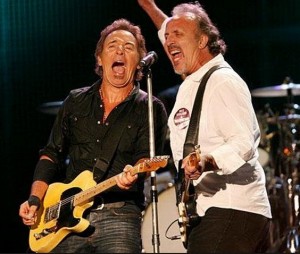 I’ve often wondered why The Iron City Houserockers never became a big national act. They were signed by a major label, MCA, right from the start. Their early songs and albums received glowing reviews from serious critics. They opened for some of the biggest acts in the business, from Bob Dylan and Dion, to Iggy Pop and Lou Reed. Heavy-hitters like Ronson, Van Zandt, Steve Cropper, and Ian Hunter arranged, mixed and produced various tracks. Through the years the band was featured on CNN, Entertainment Tonight, Solid Gold, and MTV. Maybe the music business only has so much room for what are known as “heartland rockers” — the Springsteens, the Segers, the Mellencamps, the Pettys. But it’s okay. The Houserockers will always be Pittsburgh’s own personal workingman’s band, moving the crowd with their poor-boy symphonies.
I’ve often wondered why The Iron City Houserockers never became a big national act. They were signed by a major label, MCA, right from the start. Their early songs and albums received glowing reviews from serious critics. They opened for some of the biggest acts in the business, from Bob Dylan and Dion, to Iggy Pop and Lou Reed. Heavy-hitters like Ronson, Van Zandt, Steve Cropper, and Ian Hunter arranged, mixed and produced various tracks. Through the years the band was featured on CNN, Entertainment Tonight, Solid Gold, and MTV. Maybe the music business only has so much room for what are known as “heartland rockers” — the Springsteens, the Segers, the Mellencamps, the Pettys. But it’s okay. The Houserockers will always be Pittsburgh’s own personal workingman’s band, moving the crowd with their poor-boy symphonies.
Today’s group, which includes original member Art Nardini, is always in big demand. I saw Joe and the guys play last month at the Flood City Music Festival in Johnstown, PA, and guess what? They’re still pumpin’ and sweatin’ that rock-and-roll steel just as hard as ever.
Is it just a coincidence that the photo on the back cover of The Houserockers’ first album, “Love’s So Tough,” looks so much like the picture on the back of Bruce’s second LP, “The Wild, The Innocent, and the E Street Shuffle”? Great minds think alike.
© Dana Spiardi, Sept 7, 2015
]]>
My trip to the South Hills of Pittsburgh lasted the entire length of the album. From Rt. 22 East and the harmonica opening of “Thunder Road,” right down to the closing “Jungleland” howl on Mt. Lebanon Boulevard, I kept feeling like I had to pull over and talk about it to somebody, or at least scribble down my now-grown-up reactions to an album I first heard at age 15. But I was flying solo and had a date to keep. So I rode on, with eyes burning, hoping my best words and ideas would hang around in my brain till I could get home and put them all on paper.
There’s so much to say about the sound of the music on “Born to Run.” But writing about music is like dancing about architecture, someone once said. You just can’t do it justice. So, I’ll stick with the lyrics, because words are something I know a little about. In particular, I want to unravel my thoughts on the LP’s wistful opening song, named for the title of a movie Bruce had never actually seen at the time: the 1958 Robert Mitchum film “Thunder Road.”
Here are my favorite words from a song jammed full of lyrics painted in motor oil on a canvas of desperation. The boy from Freehold was giving the boy from Hibbing a run for his money with this one.
There were ghosts in the eyes
Of all the boys you sent away.
They haunt this dusty beach road
In the skeleton frames of burned out Chevrolets.
They scream your name at night in the street,
Your graduation gown lies in rags at their feet.
 Oh, Mary with the waving dress! Only the lonely know the heartaches she’s been through. She’s on the porch of her beachfront shack-fortress, part Boo Radley, part Greta Garbo. All of them myths. Out ahead is a killer in the sun….a road that brings the greaser boys in their muscle cars to worship at her altar, night after starless night. She can hear them out in the mist, screaming her name. But when she throws open the screen door and runs outside, they’re gone in the salty wind. Could it be they only exist in her mind? Doesn’t matter. They’re not what she wants, anyway. They can’t take her any farther than the end of that dark road. So she waits, in her thin shapeless cotton dress, throwing roses in the rain, ready for a savior to rise from the streets. What are the chances of ever finding him? Slim. It’s a town full of losers, after all. But unlike all her imaginary losers, one is real, and he gives her her best and final offer: come down from your front porch, climb into my front seat, untie your hair, and let these two lanes take us away to some kind of paradise, way past the tracks. Trade in your wings for my wheels. I may not be what you want, but maybe I’m just a little bit of what you need — at least until the screen door slams and locks you in your loneliness again.
Oh, Mary with the waving dress! Only the lonely know the heartaches she’s been through. She’s on the porch of her beachfront shack-fortress, part Boo Radley, part Greta Garbo. All of them myths. Out ahead is a killer in the sun….a road that brings the greaser boys in their muscle cars to worship at her altar, night after starless night. She can hear them out in the mist, screaming her name. But when she throws open the screen door and runs outside, they’re gone in the salty wind. Could it be they only exist in her mind? Doesn’t matter. They’re not what she wants, anyway. They can’t take her any farther than the end of that dark road. So she waits, in her thin shapeless cotton dress, throwing roses in the rain, ready for a savior to rise from the streets. What are the chances of ever finding him? Slim. It’s a town full of losers, after all. But unlike all her imaginary losers, one is real, and he gives her her best and final offer: come down from your front porch, climb into my front seat, untie your hair, and let these two lanes take us away to some kind of paradise, way past the tracks. Trade in your wings for my wheels. I may not be what you want, but maybe I’m just a little bit of what you need — at least until the screen door slams and locks you in your loneliness again.
Growing up – not a beauty, but bordering on alright – there were no boys roaring away from my front porch, rejected and lovelorn, their engines blazing with anger. (I didn’t even have a porch). There were no ghosts calling my name at night. The only savior that would rise from my streets would come in the form of a round piece of vinyl on a cheap Sears record player. Like Mary, I whiled away far too many hours, hiding ‘neath my covers and studying my pain, cursing my town full of losers, feeling restless and bored and imagining that life was better someplace else. Sure, I had loving parents, decent grades, a few loyal friends, and a rock-n-roll I.V. drip by my bed. But still I longed for the day I’d shed my graduation gown at the feet of the small-town snobs and the unenlightened. Somewhere in the back of my mind I knew it was gonna be an eternity before I traded in my training-wheels for wings.
But the day would finally come when I pulled out of town – not to win, whatever that means – just to get out. I never wanted to be top of the list, king of the hill, A-number-1. I never wanted the boys or the cars. No, I wanted to find meaning and artistic expression and fulfilling work and, ultimately, self-acceptance. And eventually, in the lonely cool before or after many a dawn, I started to get a little closer to casing that promised land. It took many years of throwing roses in the mud to realize that what I thought I wanted was there all along. I walked out the back door, climbed into the front seat, and found someone already sitting there: me….with my redemption purring gently beneath the hood.
[ADDITION on August 25, 2019:]
Ah, what a lovely way to wrap things up — spinning Bruce’s song into a personal tale that encourages teenage girls to follow their dreams, embrace their own power, and accept themselves as they are.
The reality is, I’m still climbing….sometimes crawling…. into that getaway car every day — chasing a dream, looking for redemption, praying for acceptance. Finding ME.
Bruce’s working title for “Thunder Road” was “Wings for Wheels.” He originally wrote the “skeleton frames” lyric as “skeletons found by exhumed shallow graves.” Doesn’t have quite the same ring, does it? Good thing he lightened it up a bit. Now, sit back and take a journey down the two-lane with Mary and her dreamer-greaser boyfriend as they grab one last chance to make it real.
© Dana Spiardi, August 25, 2015
]]>
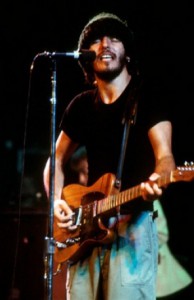 Growing up in extreme poverty may have driven James Brown to work till exhaustion, but what inspired a middle-class white boy from Long Branch, New Jersey, to rock his heart out onstage for four hours, night after night, from beach bars to coliseums? His love of his fans is one easy answer. But it goes much deeper than that, as I learned after reading a fascinating profile of Bruce in the July 2012 issue of The New Yorker magazine.
Growing up in extreme poverty may have driven James Brown to work till exhaustion, but what inspired a middle-class white boy from Long Branch, New Jersey, to rock his heart out onstage for four hours, night after night, from beach bars to coliseums? His love of his fans is one easy answer. But it goes much deeper than that, as I learned after reading a fascinating profile of Bruce in the July 2012 issue of The New Yorker magazine.
Like many artists with complicated backgrounds, Bruce has had his share of alienation, self-doubt, and can’t-please-Daddy issues. He is quoted in The New Yorker article as saying that his tireless on-stage energy was often driven by “pure fear and self-loathing and self-hatred.” Yes, folks, one of the most famous and talented men on the planet has looked deep within himself and wondered: What does it all mean? What do I do next? In a remarkable display of self-honesty, he told writer David Remnick:
“My issues weren’t as obvious as drugs. Mine were different, they were quieter—just as problematic, but quieter. With all artists, because of the undertow of history and self-loathing, there is a tremendous push toward self-obliteration that occurs onstage. It’s both things: there’s a tremendous finding of the self while also an abandonment of the self at the same time. You are free of yourself for those hours; all the voices in your head are gone. Just gone. There’s no room for them. There’s one voice, the voice you’re speaking in.”
Bruce literally wore himself out on stage. Because for those three or four hours he could use rock and roll as a great escape, and take the audience along as he went riding out to case the promised land.
Years ago when I first heard Bruce’s song “Somewhere in the Night” I latched onto a particular lyric: Turn the radio up loud, so I don’t have to think. It’s always been that way for me. Turn the volume dial up to 11 and let me rock the reality out of my head for a while. Like Bruce, I understand the therapeutic value of burying myself in music, art…and work. I write a pop culture blog that is followed by a few loyal friends and music fans. I don’t do this for money or fame. I don’t consider it a hobby; I think of it as my work. I write about the things that feed my soul, and if I happen to enlighten someone along the way, I’m happy. But, deep down, I’m truly writing to satisfy ME. Like Bruce, I’m free of myself, and living in the moment. There’s one voice: the voice I’m writing in. All the other chatter in my head is gone. I manage to silence the itty-bitty-shitty committee that says, you’re a loser….you’re a fraud….you’re lazy and self-absorbed….everyone you know is happier and more fulfilled than YOU….your friends secretly loathe you….you’re going to wither away and die in a crummy nursing home, with no one to visit you….you coulda/shoulda/woulda gone farther in life IF you’d done THIS not THAT. For most of my life I’ve been seeking ways to deal with the root causes of those inner fears, and not just bury them away. I’ve immersed myself in psychotherapy, 12-step recovery programs, hypnosis, both homeopathic and Big Pharma anti-depressant medication regiments, consultations with astrologers, tarot readers, aroma therapists, and chakra balancers, and spiritual practices galore. And it’s all helped. But, on days and nights when the voices get too loud, the only way to escape is through creative work.
Most nights I write till I’m so tired I can collapse into bed and fall fast sleep before the fear of tomorrow starts creeping into that scary neighborhood I call my brain. Some people accomplish this form of escapism with a cocktail. (Been there, done that.) Now I do it with a keyboard. Like Bruce, I immerse myself in my creative work to stay free of the bondage of self. No chemical substance on earth can chase away the demons and revitalize a paralyzed soul like experiencing music and art head-on, and spreading the gospel.
Bruce Springsteen is considered a hero of the working class. Yet, he never labored in a steel mill, coal mine, or car wash. Much of what he knew about the working life came from watching his frustrated father float from job to job: bus driver, millworker, prison guard. Bruce made his bones singing about disillusioned men who toil away at mind-numbing work — people who always seem to take one step up and two steps back. His songs can fill you with hope and wild abandon, inspiring you to head straight into the storm. Or, they can leave you wanting nothing more than to hide ‘neath your covers and study your pain.
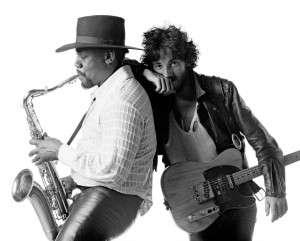
I have a long history with Bruce Springsteen. Back when I discovered him in 1975, he was still singing about boy-prophets and Tilt-a-Whirls, Southside sisters and subway sages, cool Romeos and late Juliets who sat on fire escapes and skipped school. I liked that Bruce the best, because those songs were about romantic escapism. Later, when he started singing sad ballads about cities in ruin and desperate people with dead-end lives, it was more reality than I could handle.
But whether I dig the desolate songs or not, I continue to see his shows — over 30 since 1976 — and I salute him for his seemingly innate ability to pen lyrics that strike deep chords in our collective subconscious. Whether you sit behind a mahogany desk or stand behind a jack-hammer, is there any one of you who has not related to this lyric from “The Promised Land” at one time or another in your working life?
I’ve done my best to live the right way,
I get up every morning and go to work each day.
But your eyes go blind and your blood runs cold,
Sometimes I feel so weak I just wanna explode.
Bruce is a true original. And whether or not I embrace every one of his albums is a moot point. Because, like all real artists, he follows his soul. The fact that he’s made millions from 40 years of delivering us from evil with his rock gospel revival shows hasn’t changed the fact that Bruce Springsteen will never be satisfied. He’ll keep pushing till it’s understood. And brother, that’s the story of my life.
Said Springsteen in the New Yorker article: “I’m thirty years in analysis! Look, you cannot underestimate the fine power of self-loathing in all of this.” (I feel ya, Brucie, most definitely.) “You think, I don’t like anything I’m seeing, I don’t like anything I’m doing, but I need to change myself, I need to transform myself. I do not know a single artist who does not run on that fuel. If you are extremely pleased with yourself, nobody would be fucking doing it! Brando would not have acted. Dylan wouldn’t have written ‘Like a Rolling Stone.’ James Brown wouldn’t have gone ‘Unh!’ He wouldn’t have searched that one-beat down that was so hard. That’s a motivation, that element of ‘I need to remake myself, my town, my audience’—the desire for renewal.”
Thanks, Bruce, for inspiring me to find release and renewal through the power of music, art, self-expression, and hard work.
Abandon yerselves, boys and girls!
© Dana Spiardi, September 3, 2012
]]>
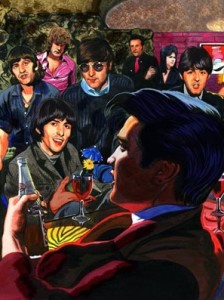 By the mid-1960s the sharecropper’s son from Tupelo, Mississippi, had begun to develop a suspicious mind regarding the new crop of electrified rockers – especially four long-haired boys from England who were inciting even bigger riots than he did at the height of his fame. But The Beatles were oblivious to all that; part of the thrill of conquering America was the chance to finally meet their idol. After much logistical wrangling, Elvis handler “Colonel” Parker and Beatles manager Brian Epstein finally arranged a get-together on the evening of August 27, 1965. The Beatles were staying in a rented house in Los Angeles, having just played two shows at the Hollywood Bowl. They were to visit Elvis at his home on Perugia Way in Bel Air, where he was relaxing after completing his latest film. The meeting began in an uneasy manner, with the awestruck Beatles at a loss for words (even John!). Finally, Elvis said, “If you guys are just going to sit around and stare at me, I’m going to bed.” That broke the ice, and The King and his adoring subjects spent the next four hours shooting pool, listening to records, jamming with Elvis’s guitars, and talking about current movies. But the relationship ended there. Years later Elvis would criticize the Beatles for what he called their “anti-American spirit.”
By the mid-1960s the sharecropper’s son from Tupelo, Mississippi, had begun to develop a suspicious mind regarding the new crop of electrified rockers – especially four long-haired boys from England who were inciting even bigger riots than he did at the height of his fame. But The Beatles were oblivious to all that; part of the thrill of conquering America was the chance to finally meet their idol. After much logistical wrangling, Elvis handler “Colonel” Parker and Beatles manager Brian Epstein finally arranged a get-together on the evening of August 27, 1965. The Beatles were staying in a rented house in Los Angeles, having just played two shows at the Hollywood Bowl. They were to visit Elvis at his home on Perugia Way in Bel Air, where he was relaxing after completing his latest film. The meeting began in an uneasy manner, with the awestruck Beatles at a loss for words (even John!). Finally, Elvis said, “If you guys are just going to sit around and stare at me, I’m going to bed.” That broke the ice, and The King and his adoring subjects spent the next four hours shooting pool, listening to records, jamming with Elvis’s guitars, and talking about current movies. But the relationship ended there. Years later Elvis would criticize the Beatles for what he called their “anti-American spirit.”
Through the years, the increasingly medicated Elvis would meet increasingly odd fans who idolized him. Some encounters were quite bizarre, like the time in 1970 when he invited Alice Cooper, Liza Minnelli, Chubby Checker, and Deep Throat porn star Linda Lovelace to his Las Vegas penthouse after a show. What an ensemble! Shock-rocker Cooper later told The London Mirror: “Elvis took me into the kitchen, opened a drawer, and pulled out a loaded pistol, telling me to put it to his head. A little voice in my left ear was telling me, ‘Go on, this is history — kill him. You’ll always be the guy who killed Elvis.’ A fraction of a second later Elvis did a flying kick on the gun and sent it flying, before tripping me and pinning me to the ground by my neck, announcing, ‘That’s how you stop a man with a gun.'”
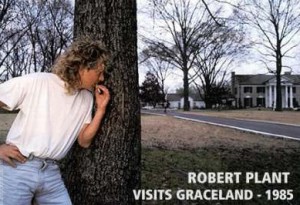 Elvis owned quite an arsenal, but guns or no guns, he was still a few years away from climbing that final stairway to heaven when he met the hard rocking Led Zeppelin. Sometime in the early ’70s (dates vary), the four members of the British band attended an Elvis concert, during which The King gave them a nice shout-out from the stage. Legend has it that Elvis stopped singing a song and jokingly told his band, “Wait a minute…if we can start together fellas, because we’ve got Led Zeppelin out there…let’s try to look like we know what we’re doing.” At this point, Zeppelin albums were outselling Elvis records by the millions. But the rock gods posed no threat to the man whose devoted worldwide fans outnumbered theirs, then and now. One night after a show, Elvis agreed to meet Zeppelin’s two frontmen – guitarist Jimmy Page and singer Robert Plant – in his hotel suite. And no, they didn’t spend the night browsing through Elvis’s personal copy of The Physician’s Desk Reference.
Elvis owned quite an arsenal, but guns or no guns, he was still a few years away from climbing that final stairway to heaven when he met the hard rocking Led Zeppelin. Sometime in the early ’70s (dates vary), the four members of the British band attended an Elvis concert, during which The King gave them a nice shout-out from the stage. Legend has it that Elvis stopped singing a song and jokingly told his band, “Wait a minute…if we can start together fellas, because we’ve got Led Zeppelin out there…let’s try to look like we know what we’re doing.” At this point, Zeppelin albums were outselling Elvis records by the millions. But the rock gods posed no threat to the man whose devoted worldwide fans outnumbered theirs, then and now. One night after a show, Elvis agreed to meet Zeppelin’s two frontmen – guitarist Jimmy Page and singer Robert Plant – in his hotel suite. And no, they didn’t spend the night browsing through Elvis’s personal copy of The Physician’s Desk Reference.
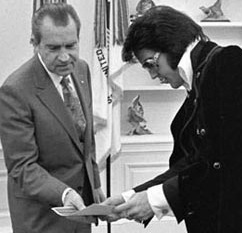 Here’s how Plant described the encounter to Paul Cole in the British tabloid Sunday Mercury: “As we all chatted, Jimmy Page joked with Elvis that we never bothered much to do soundchecks before our gigs. But when we did do them, all I wanted to do was sing Elvis songs! Elvis thought that was really funny and asked me what my favourite song was, which tunes I enjoyed the most. I told him I liked the ones with all the moods, like that great country song ‘Love Me.’ You know, the one that goes: Treat me like a fool, treat me mean and cruel, but love me. We had an illuminating and funny 90 minutes with Elvis. When we were leaving, I was just walking down the corridor when he swung ’round the door frame, looking quite pleased with himself, and started singing that song to me: Treat me like a fool… I turned around and did my best Elvis right back at him. We stood there for quite a while, singing to each other!” Imagine — two of the world’s most sought-after hunks, serenading each other in a hallway. Oh, to have had cell phone video cameras back then.
Here’s how Plant described the encounter to Paul Cole in the British tabloid Sunday Mercury: “As we all chatted, Jimmy Page joked with Elvis that we never bothered much to do soundchecks before our gigs. But when we did do them, all I wanted to do was sing Elvis songs! Elvis thought that was really funny and asked me what my favourite song was, which tunes I enjoyed the most. I told him I liked the ones with all the moods, like that great country song ‘Love Me.’ You know, the one that goes: Treat me like a fool, treat me mean and cruel, but love me. We had an illuminating and funny 90 minutes with Elvis. When we were leaving, I was just walking down the corridor when he swung ’round the door frame, looking quite pleased with himself, and started singing that song to me: Treat me like a fool… I turned around and did my best Elvis right back at him. We stood there for quite a while, singing to each other!” Imagine — two of the world’s most sought-after hunks, serenading each other in a hallway. Oh, to have had cell phone video cameras back then.
Paul Simon once sang, “I’ve a reason to believe we all will be received in Graceland.” And indeed, millions of fans – including hundreds of rock stars – have been welcomed at Elvis’s former estate since it opened for public tours in 1982, five years after his death. Few, if any, musicians were lucky enough to be invited to the house while Elvis occupied it. But one late night in 1976, a skinny Jersey boy on the cusp of superstardom had the chutzpah to drop by the mansion, uninvited, to pay Elvis a personal visit. (Much like The King had once dropped by The White House, uninvited, to pay Richard Nixon a visit.)
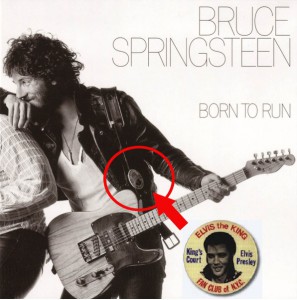 Bruce Springsteen is one of the world’s biggest Elvis fans. Like scores of boys growing up in the 1950s, he asked his mom to buy him a guitar the very day after seeing the singer perform on The Ed Sullivan Show. Flash forward to 1976: Bruce was in the middle of his phenomenal “Born to Run” tour to promote his third LP. Despite having been featured on the covers of both Time and Newsweek magazines on the same date – October 27, 1975 – he was still a bit of a cult star, playing small clubs and college auditoriums. On April 29 of the following year, Bruce and the E Street Band had just wrapped up another one of their four-hour extravaganzas, this one in Memphis. A wired-up Bruce decided the time was ripe to visit the man who started the whole ball rolling. So, with sidekick Steven Van Zandt in tow, he hailed a cab to Graceland, saw a light in an upstairs window, and knew just what he had to do: walk right up to the front door, ring the bell, and ask to see Elvis. Now, if he could just jump over that wall and convince those security guards…
Bruce Springsteen is one of the world’s biggest Elvis fans. Like scores of boys growing up in the 1950s, he asked his mom to buy him a guitar the very day after seeing the singer perform on The Ed Sullivan Show. Flash forward to 1976: Bruce was in the middle of his phenomenal “Born to Run” tour to promote his third LP. Despite having been featured on the covers of both Time and Newsweek magazines on the same date – October 27, 1975 – he was still a bit of a cult star, playing small clubs and college auditoriums. On April 29 of the following year, Bruce and the E Street Band had just wrapped up another one of their four-hour extravaganzas, this one in Memphis. A wired-up Bruce decided the time was ripe to visit the man who started the whole ball rolling. So, with sidekick Steven Van Zandt in tow, he hailed a cab to Graceland, saw a light in an upstairs window, and knew just what he had to do: walk right up to the front door, ring the bell, and ask to see Elvis. Now, if he could just jump over that wall and convince those security guards…
In the video below, Bruce tells the entire funny story. It used to be one one of his favorite concert tales. The song he sings in homage to Elvis is called “Johnny Bye Bye,” based on the old Chuck Berry tune, “Bye Bye Johnny.” Nobody pays tribute to the founding fathers, or articulates rock-roll passion, quite the way Bruce does. What a pity the man we call The Boss never got to meet the man we’ll always call The King. They woulda got on like a house on fire.
Leaving Memphis with a guitar in his hand
With a one way ticket to the Promised Land
Hey little girl with the red dress on
There’s a party tonight down in Memphis town
I’ll be going down there if you need a ride
The man on the radio says Elvis Presley’s died
Bye bye Johnny
Johnny bye Bye
You didn’t have to die
You didn’t have to die
© Dana Spiardi, May 2, 2013
]]>
The characters from Bruce’s 1973 LP sprang from the Hollywood-styled world of Hell’s Kitchen, Paradise Alley, and The Boulevard of Broken Dreams. They had nicknames like Spanish Johnny, Puerto Rican Jane, Little Angel, Sloppy Sue, Diamond Jackie, Easy Joe, Little Dynamite. Losers all, but lovable as only Bruce could draw them.
Those outsiders – with their bruised arms, broken rhythm and beat-up old Buicks – are so alive to me, the imagery so vivid – like this scenario from “Incident on 57nd Street,” my favorite Bruce song: Janey sleeps in sheets damp with sweat / Johnny sits up alone and watches her dream on, dream on / And the sister prays for lost souls / then breaks down in the chapel after everyone’s gone. Hokey and overly sentimental? Perhaps. But this is the stuff that makes my heart ache in a really wonderful way. Every lyric and every melody on this LP can still move me to tears. These are coming-of-age songs for me. For we early Springsteen fans, this era – this zeitgeist – is gone forever.
I was 16 years old when I spied a small poster in the window of a record store at the old Richland Mall near Johnstown, PA: “Bruce Springsteen and the East (sic) Street Band – Coming to the Cambria Country War Memorial Arena on April 12, 1976.” General admission: $5.50. I pleaded with my overly-protective mom that I needed to see “the future of rock-n-roll.” And miracle of miracles, she and my dad agreed to drive me to the show. (She must have had a sixth sense about “sure things,” having plopped me down in front of the television at age 4 to witness the Beatles’ debut on the Ed Sullivan show. “This will be important one day,” she said.)
It’s funny…I was a junior in high school and no one asked me to the Prom that year; but I couldn’t have cared less, because I was the only one in my school who had tix to see BRUUUUCE!
That Johnstown show – my first rock concert – changed my life. I would never see another live event that would match the magic and intensity of that performance. Bruce and his band – which by this time included his lifelong rock-n-roll soul mate “Miami Steve” Van Zandt – entertained a crowd 4,000 early-believers for four hours. They played two encores, then charged back onto the stage for a third after the house lights came up. My jukebox-graduate friend Barb and I were on our feet from the opening machine-gun guitar fire of “Night” to the closing sax sirens of “Twist and Shout.” The interplay between 5-foot-9 Bruce (in black tux with no tie) and 6-foot-5 sax player Clarence “Big Man” Clemons (in Panama suit and hat) was brotherhood incarnate. When the concert was over, I (in my red fedora with feather) felt that God could take me any time he was ready. My rock-n-roll soul was completely satiated.
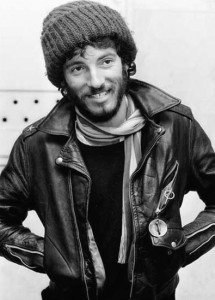 The rest, as they say, is history. By the end of the “Born to Run” tour, Bruce would belong to the rest of the world. (And I’d have to work really hard to get tickets!) He released his long-awaited “Darkness on the Edge of Town” LP to rave reviews. This hauntingly beautiful album – full of darkness and light, promise and doubt – is Bruce’s personal favorite and a top pick of many rock critics. The record depicts a man born into this life, paying for the sins of somebody else’s past. Bruce had left the boardwalk forever to enter those rusted factory gates. For me, these songs were just plain sad. The darkness on the edge of town was calling me, but the quirky street characters weren’t there to pull me in.
The rest, as they say, is history. By the end of the “Born to Run” tour, Bruce would belong to the rest of the world. (And I’d have to work really hard to get tickets!) He released his long-awaited “Darkness on the Edge of Town” LP to rave reviews. This hauntingly beautiful album – full of darkness and light, promise and doubt – is Bruce’s personal favorite and a top pick of many rock critics. The record depicts a man born into this life, paying for the sins of somebody else’s past. Bruce had left the boardwalk forever to enter those rusted factory gates. For me, these songs were just plain sad. The darkness on the edge of town was calling me, but the quirky street characters weren’t there to pull me in.
By 1984 Bruce had became an international superstar upon the release of his hit-filled album “Born in the USA.” The music execs prettied him up with dermabrasion and dental work. A buff Bruce with carefully-placed bandanas embarked on massive tours of 100,000-seat stadiums. He’d go on to sing soaring anthems and heartfelt ballads with serious social messages, helping to lift up Americans in troubled times. It is all good and necessary. Like any true artist, Bruce is constantly evolving. I deeply respect and admire his social consciousness. But still, deep inside, I miss the early days when Bruce sang I ain’t here on business baby, I’m only here for fun.
Springsteen is a true American working class hero. Bono said it best when he inducted Bruce into the Rock-n-Roll Hall of Fame in 1999: “We call him the Boss. Well that’s a bunch of crap. He’s not the boss. He works for us. More than a boss, he’s the owner, because more than anyone else, Bruce Springsteen owns America’s heart.”
I continue to see Bruce and the boys whenever and wherever I can (even if it means traveling to Germany to see him, as I did in 1999 with my fab friend and Backstreets sister Jane McCreery). I’m gearing up for my 25th concert on November 4, 2011. Because there is still nothing that can compare to the sheer joy and energy of a Springsteen show.
Here’s my all-time favorite Springsteen song, “Incident on 57th Street,” from his second LP. Goodnight, it’s alright, Jane.
© Dana Spiardi, Nov 2, 2011
]]>
